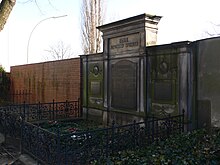Ferdinand Springer senior
Ferdinand Springer senior (born July 21, 1846 in Berlin , † December 27, 1906 in Berlin) was a German publisher .
Life
Ferdinand Springer was the eldest son of Julius Springer , the founder of the bookstore of the same name. Springer attended the Friedrichs-Gymnasium in Berlin and until 1864 the Pforta state school . He received his training in the Wilhelm Hertz bookstore in Berlin. Springer gained further experience in bookshops in Bremen and Bern . He did his military service as a volunteer with the Brandenburg Fusilier Regiment No. 35.
After participating in the Franco-Prussian War , Springer joined his father's publishing house in 1871. After his father's death in 1877, he continued to run the publishing house under the traditional name. The bookstore had already been sold in 1858.
Springer was particularly successful in founding scientific journals, from which he developed flourishing publishing branches. Through contacts with Reich authorities (e.g. Imperial Health Office, Reich Railway Office, Reich Post Office), associations, federations and companies, he won numerous authors. In 1880, Springer took his younger brother Fritz Springer (1850-1944), a qualified engineer , into the publishing house. With him began the development of the technology publishing house, one of the most important in Germany. The close connection to the Association of German Engineers also contributed to this.
In 1901, Springer had a noble country house built by the architect Alfred Messel on the Großer Wannsee , across from the property of the painter Max Liebermann , which "went down in Berlin building history as one of the first and most perfect country houses based on the English and American models." After being sold by the heirs at the beginning of the 1920s during the Nazi era, it initially opened an office for the German Labor Front and then served as a Reich training castle for the NSDAP from 1940 to 1945 . The building, which was converted into an apartment building in 1979, is listed as a monument ; however , the landscaped garden of the property, also designed by Messel, has been lost. In 1904 Ferdinand Springer also acquired a neighboring property on the lake and had Max Landsberg build a tea pavilion there that had not been preserved.
Ferdinand Springer, who advocated economic liberalism , was initially far removed from Adolf Kröner's book trade reforms , but in 1904 he acknowledged their principles at the adversarial negotiations in Berlin. The main concern was fixed book prices, which still exist today. In 1904 Springer and his brother Fritz took their eldest sons Ferdinand Springer junior and Julius Springer the elder . J. joined the publishing house and made them partners in 1906.
Ferdinand Springer died in Berlin in 1906 at the age of 60 and was buried in the Matthäus-Kirchhof in Schöneberg , in a hereditary funeral that he was born after the death of his first wife Anna. Gorizia (1852-1885) had acquired. The wall grave made of gray limestone, created by W. Martens, has three axes and is dominated by the raised central section with inscription panels made of black granite in all three wall fields. Many of the decorative decorative elements in the complex were lost after 1945. Springer's widow Emilie nee Koeniger (1855–1945) found her final resting place here. In 1986 the grave grate was restored with funds from the publisher.
literature
- Alexander Franke: Ferdinand Springer 1846-1906. In: Address book of the German book trade. Leipzig 1908, pp. III-XXIII.
- Gerhard Menz: The Springer House. In: German booksellers. Leipzig 1925, pp. 185-194.
- Heinz Sarkowski: The Springer publishing house. Stations in its history. Part 1: 1842-1945. Berlin 1992, ISBN 3-540-55221-9 .
Web links
Individual evidence
- ↑ a b Description of the "Springer House" in the database of the Berlin State Monuments Office (accessed on February 26, 2019).
- ^ Myra Wahrhaftig: German Jewish architects before and after 1933. Lexicon. 500 biographies . Reimer, Berlin 2005, ISBN 3-496-01326-5 , p. 295.
- ↑ Hans-Jürgen Mende: Alter St. Matthäus-Kirchhof Berlin. A cemetery guide . 3rd, revised and expanded edition. Edition Luisenstadt, Berlin 2012, ISBN 978-3-936242-16-4 , p. 20.
| personal data | |
|---|---|
| SURNAME | Springer, Ferdinand senior |
| BRIEF DESCRIPTION | German publisher |
| DATE OF BIRTH | July 21, 1846 |
| PLACE OF BIRTH | Berlin |
| DATE OF DEATH | December 27, 1906 |
| Place of death | Berlin |


